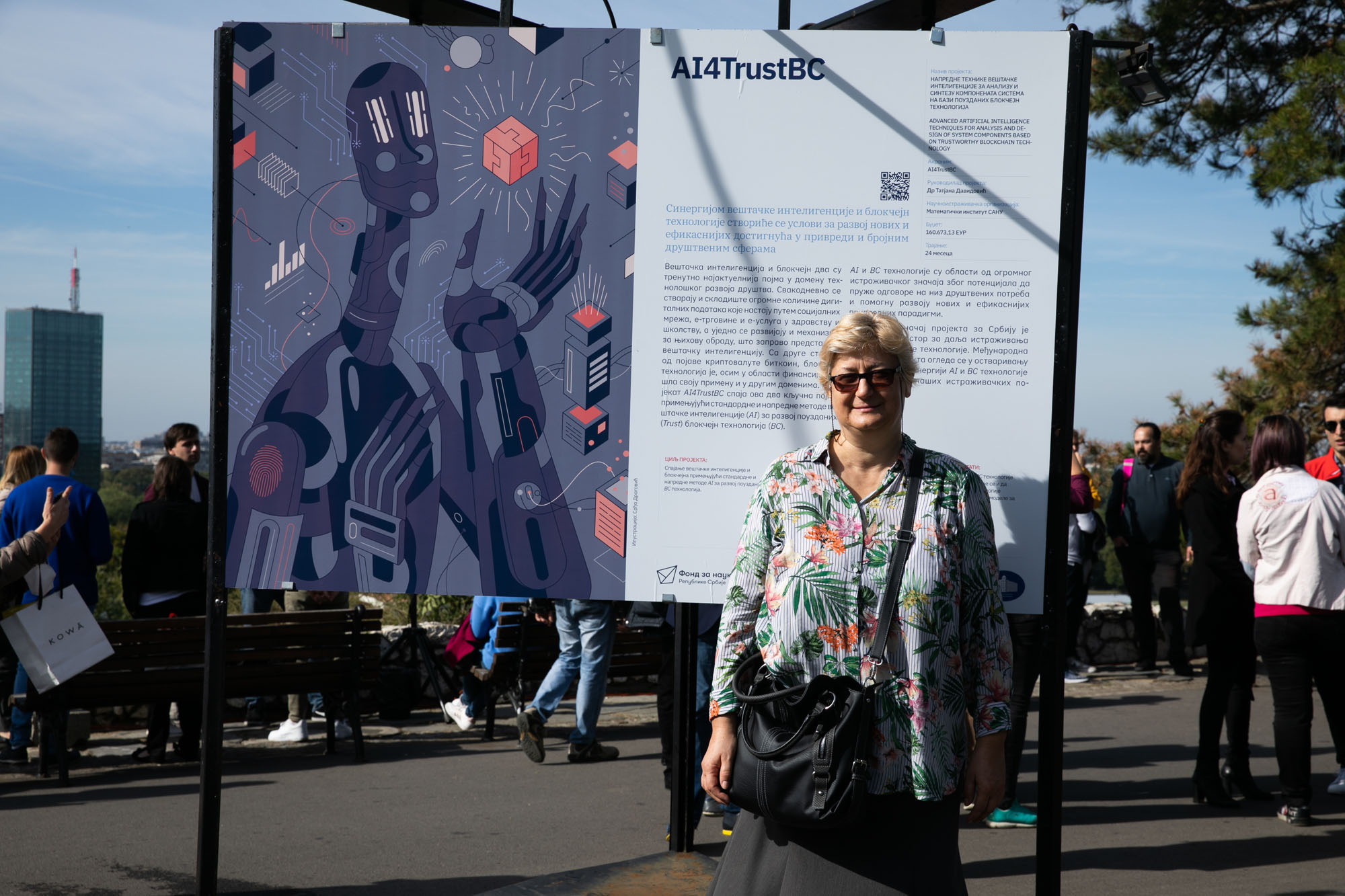Project AI4TrustBC
Advanced Artificial Intelligence Techniques for Analysis and Design of System Components Based on Trustworthy BlockChain Technology
Principal Investigator:
Tatjana Davidović
Home page of the project
2020-2022, supported by the
Science Fund of the Republic of Serbia
fundamental research in Artificial Intelligence program.
BlockChain (BC) is a specially designed distributed data storage structure, maintained without any third party of absolute trust by the so-called consensus protocol. BC is distributed among the nodes (users, agents) of the corresponding network in such a way that each node holds an accounting system based on the same public ledger, recording information about all transactions in the network. This ledger is untampered and append-only. The first BC implementation was related to the financial domain - performing transactions with Bitcoin cryptocurrency. Nowadays, it can be applied to different domains (digital identity, voting, by notaries, smart contracts, IoT, insurance, healthcare, etc.). BC could be regarded as a public ledger where all data (referred to as "committed transactions") are stored in a list of blocks. New data (organised in blocks) are allowed to be added simultaneously. The main issues in maintaining BC are security, privacy, consistency, and reducing the consumption of electrical energy.
One of the most important tasks in designing and implementing BC is to enable the consistency of distributed data, i.e. to ensure that each copy of data contains the same value. Another important task is to disable the analysis and knowledge discovery of recorded data that would raise the privacy issues and compromise the entire system. Consequently, the evaluation of the system security is one of the essential tasks that should engage advanced approaches and techniques, which, on the other hand, should provide basis for the construction of safer components of the BC based systems. In addition, huge energy consumption is identified as the most significant drawback of BC systems. In order to include a new block in BC, the consensus protocol has to be performed. Actually, the consensus algorithm is responsible for maintaining the integrity and security of the whole BC based system and it is employed in order to provide the validity of transactions, as well as to ensure that the validity of a transaction becomes common knowledge to all agents. Therefore, one of the crucial properties in the BC consensus protocol is to guarantee that in every execution step, the consensus of all involved agents is achieved and that all transactions occur in a trustful way. Consequently, the reliability and security of the consensus protocols appear as the top importance issues. A lot of consensus protocols are based on certain cryptographic puzzles related to the inversion of one-way functions. It is important to note that, besides a traditional hash function, other one-way functions could be employed, however, all of them involve complex computational tasks that require a large amount of energy. When the consensus protocol is based on solving a cryptographic puzzle, it is performed by spending certain computational resources, i.e. performing some work, and these protocols are denoted as Proof-of-Work (PoW) ones. Having in mind that consensus protocol is executed in a distributed environment, it is possible that two agents broadcast different versions of the next block simultaneously, and branching occurs in the chain. At some time periods, the synchronisation is performed in order to keep the chain structure of BC. The longest chain, i.e. the one involving larger amount of Proofs-of-Work, is favoured (it is considered to be the correct one), and all agents will keep working on extending it.
The main intention of the AI4TrustBC project is to contribute toward overcoming all these issues by applying Artificial Intelligence (AI) tools. Artificial intelligence (AI) involves various programming techniques enabling computers and other machines to perform tasks that require intelligent behaviour typical for humans and other living beings. The main characteristic of the so-called intelligent machine is the ability to learn and solve problems. AI is an interdisciplinary scientific field that involves multiple approaches, such as machine learning, intelligent computing, automated theorem proving, etc. It can be applied to various tasks related to practice and industry, with the main aim to create the machines (robots) that can replace humans in dangerous situations (mining, underwater operations, fire fighting, various rescue missions, etc.). The power of AI stems from the fact that computers perform better than humans in repetitive tasks. Their judgment and actions are not affected by emotions, feelings, and needs. They have better memories and can process larger amounts of information. AI, thus, enhances efficiency and provides new opportunities for cost savings and revenue generation. The synergy between AI and BC in cyberspace provides a number of specific benefits. For example, AI can be used to automate real-time threat detection and to learn continuously about cyber-offenders’ behaviour. AI and BC have strong complementary capabilities that dramatically affect the performance of the resulting systems, and each also has a potential to improve the performance and functioning of the other.
AI can effectively mine through a huge dataset to create newer scenarios and discover patterns based on data behaviour. Therefore, the main idea of this project is to provide contribution to the application of artificial intelligence in the BC technology domain. The following is of note:
- Defining new, intelligent consensus protocols that are more energy efficient;
- Knowledge reasoning techniques can be used to analyze consistency of consensus algorithms for BC;
- Employment of AI techniques for the analysis of anonymous data in order to evaluate robustness of the privacy
protection in certain BC ledgers.
One of the main goals of the project activities is to develop mathematical theories that support and formalise the underlying software systems. The other goal is to contribute toward resolving the main issues in maintaining BC: security, privacy, consistency, and reducing the consumption of electrical energy. For that purpose we use various methods of Artificial Intelligence (AI), both standard and advanced.
The mathematical models for data privacy-contextual integrity, differential privacy and inverse privacy need to be analyzed. The background references and consideration about the BC consensus protocols and the ledgers that are focused on reduction of power consumption and improving security of this distributed database are not extensive. This makes the topic of the project very attractive. On the other hand, the available software supports for publicly available BC databases are numerous. Identification of their characteristics, strengths and weaknesses is one of our main tasks. To tackle the problem of energy savings, the project plan is to develop the new variant of Proof-of-Useful-Work (PoUW) consensus protocol based on solving hard optimisation problems. It turns out that dealing with de-anonymisation issues requires solving community detection in directed graphs and the appropriate algorithms for this optimisation problem have to be developed.
An important application of the project research could be in fighting the Covid-19 pandemic. It has been detected that the Caller ID app privacy problem falls into the scope of inverse privacy and there is an intent to employ this connection to obtain an acceptable solution. The idea is to investigate if the BC technology can be used as a potential solution. Due to the urging problems of the Covid-19 pandemics, the conducted research could be broadened to contact tracing apps and potential privacy risks that contact tracing causes, especially during the Covid-19 pandemic.
The project members come from two scientific research institutions, the Mathematical Institute of the Serbian Academy of Sciences and Arts (MISANU) and the University of Novi Sad, Faculty of Technical Sciences (FTN). There are 12 researches involved in the project activities. Among them, five are PhD students, two of whom are early career researchers, supervised by five research professors. The participants are organised into three groups: the first group is dealing with mathematical formalisation of BC systems (by developing knowledge reasoning techniques and formal methods), the second one is involved in energy saving and de-anonymisation (by developing metaheuristic-based tools for BC), while the third group works on security/privacy evaluation of BC consensus/ledger components (based on the results obtained by the former two groups). Obviously, their tasks may overlap.
The scientific impact of this project is straightforward because its main objectives include developing of advanced techniques based on AI for security evaluation of the BC consensus protocols and privacy protection evaluation at the BC ledger. The obtained results will hopefully be published in prestigious international journals and conferences and become accessible to a wider scientific community. A high level of public interest in the results of the project will be created by dissemination activities, especially by organising an AI4TrustBC-Open Day for representatives of IT companies, government bodies, and other potential users. This event could help to initiate collaboration directed to solving practical problems.
Gallery

Presentation of the AI4TrustBC project during the exhibition organized on the Sava Promenade in Kalemegdan.
The project was presented by the project coordinator, Dr Tatjana Davidović.
(Collection of the Science Fund of the Republic of Serbia)


